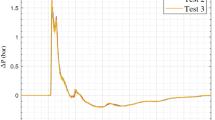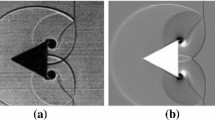Abstract
Explosions and their resulting shock waves may pose a large threat to both humans and structures alike. The previous research concludes that a logarithmic spiral configuration is effective in focusing shock waves to a focal point. This research outlines shock tube experiments conducted on two types of solid rectangular obstacles placed in a logarithmic spiral shape. The obstacles have a square cross-sectional area, with one set of obstacles being normal square shapes, but the other set of obstacles have three grooves cut out on every side of the obstacle, thus reducing the cross-section area by 10%. High-speed schlieren photography is used to visualize the shock waves and numerical simulations provide supporting data. A comparison in regards to shock wave attenuation between the two obstacle sets is presented. Results conclude that the three-groove obstacle geometry was successful in attenuating the peak pressure and pressure impulse of a reflected shock wave; however, the results for the transmitted shock wave between the two configurations are again inconclusive.












Similar content being viewed by others
References
Andreopoulos Y, Zanthos S, Subramanian K (2007) Moving shocks through metallic grids: their interaction and potential for blast wave mitigation. Shock Waves 16:455–466
Berger S, Sadot O, Ben-Dor G (2010) Experimental investigation on the shock-wave load attenuation by geometrical means. Shock Waves 20:29–40
Berger S, Ben-Dor G, Sadot O (2015) Experimental and numerical investigations of shock-wave attenuation by geometrical means: a single barrier configuration. Euro J Mech B/Fluids 50:60–70
Britan A, Igra O, Ben-Dor G, Shapiro H (2006) Shock wave attenuation by grids and orifice plates. Shock Waves 16:1–15
Chaudhuri A, Hadjadj A, Sadot O, Ben-Dor G (2013) Numerical study of shock-wave mitigation through matrices of solid obstacles. Shock Waves 23:91–101
Henshaw W, Schwendeman D (2003) An adaptive numerical scheme for high-speed reactive flow on overlapping grids. J Comput Phys 191:420–447
Henshaw W, Schwendeman D (2006) Moving overlapping grids with adaptive mesh refinement for high-speed reactive and non-reactive flow. J Comput Phys 216:774–779
Igra O, Wu X, Falcowitz J, Meguro T, Takayama K, Eilig W (2001) Experimental and theoretical study of shock wave propagation through double-bend ducts. J Fluid Mech 437:255–282
Igra O, Falcowitz J, Houas L, Jourdan G (2013) Review of methods to attenuate shock/blast waves. Prog Aerosp Sci 58:1–35
Milton B, Archer R (1969) Generation of implosions by area change in a shock tube. AIAA J 7:779–780
Seeraj S, Skews B (2009) Dual-element directional shock wave attenuators. Exp Therm Fluid Sci 33:503–516
Shi H, Yamamura K (2004) The interaction between shock waves and solid spheres arrays in a shock tube. Acta Mech Sin 20:219–227
Wan Q, Eliasson V (2015) Numerical study of shock wave attenuation in two-dimensional ducts using solid obstacles—how to utilize shock focusing techniques to attenuate shock waves. Aerospace 2:203–221
Acknowledgements
We thank Mr N. Amen for participating in useful discussions with our undergraduate student researchers. We greatfully acknowledge Mr Heng Liu for his assistance with the numerical simulations.
Author information
Authors and Affiliations
Corresponding author
Ethics declarations
Conflict of interest
On behalf of all authors, the corresponding author states that there is no conflict of interest.
Additional information
Publisher's Note
Springer Nature remains neutral with regard to jurisdictional claims in published maps and institutional affiliations.
This study was supported by the National Science Foundation (NSF) under grant No. CBET-1437412.
Rights and permissions
About this article
Cite this article
Ivanov, A., Fassardi, N., Scafidi, C. et al. Shock wave attenuation using rigid obstacles with large- and small-scale geometrical features. Multiscale and Multidiscip. Model. Exp. and Des. 2, 269–279 (2019). https://doi.org/10.1007/s41939-019-00053-2
Received:
Accepted:
Published:
Issue Date:
DOI: https://doi.org/10.1007/s41939-019-00053-2




